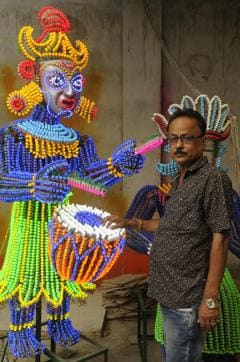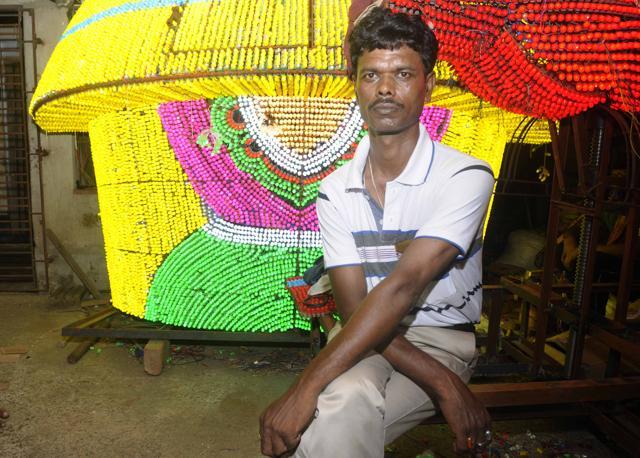The light-managers of Chandannagar
The fabled lights of Chandannagar now illuminate festivals across India, not just Kolkata’s Durga Puja celebrations
For a street that has the distinction of lighting up festivals and celebrations across the country, Bidyalanka, a neighbourhood in West Bengal’s Chandannagar (or Chandernagore) town, can hardly be accused of being bright or flashy. Electrical stores, with displays of colourful decorative lights, share space with chemist shops, grocery stores and what not. Behind the displays, men work, fitting LED lights along designs sketched on fibreglass boards – colourful blooming flowers, figures of birds and animals, clowns.

Not far off is the residence of Sridhar Das, a light artist who claims credit for having brought innovative lighting to Chandannagar.
A former French colony, Chandannagar, has long been known for its decorative light works. The colourful panels of lights would be timed and sequenced so well – one strand lighting up, as another dimmed – that it gave the impression of figures being in motion. The panels would often tell a story – snippets from some children’s fiction or else the latest news events – Tendulkar hitting a six in some match, highlights from the Olympic Games – or as in this year, scenes from the recent super hit film Bahubali.

For years the light works of Chandannagar were the pride of Durga Puja celebrations in Kolkata. In his hey days in the 1960s and 1970s, Das remembers having done the lighting for some of the most renowned and big-budget Pujas of the Bengal capital – Mohd. Ali Park, College Square, Ekdalia Evergreen, Singhi Park… the list goes on.
Looking Back
It is not really documented how Chandannagar came to be known for its lights. “We have heard from our parents and grandparents that it started in the nineteenth century. People of Chandannagar used to take out a procession during festivals. They would illuminate the procession with gas lamps set in bamboo frames. Ever since, Chandannagar came to be known for its innovative lighting,” says light artist Asim Dey, sitting in his sprawling workshop. Behind him are stacked countless boards where lights have been used to create images of bees hovering over flowers, an over-flowing mangal kalash and more.
In recent history though, Das claims to have started the trend of innovative decorative light in Chandannagar. “I was in class VII at the time. There was a Saraswati Puja celebration at my school. I volunteered to do the lights. I put small bulbs inside three empty barley tins and covered the opening with coloured cellophane paper. I sat behind the idol for the entire evening, adjusting the wires so that the lights in each of the tins would light up one by one to fall on the idol. This was the beginning of automated lighting in Chandannagar,” recalls Das, whose lightwork has been displayed at the Thames Festival in London and at events in countries like Russia. His school experiment was sometime in the 1950s. A few years later he offered to do the lights at a Jagadhatri Puja celebration – the biggest festival in Chandannagar. After that there was no looking back. Though one of the best known pioneers of lighting in Chandannagar, Das was not the only light artist in town.
The nineties, however, brought both trouble and change.

Let There Be LED
Over the years the light artists of Chandannagar had worked with various kinds of lamps – “from torch bulbs, to loop lamps and then 6volt lamps. The 6volt lamps were locally produced at factories in West Bengal’s Barasat and Madhyamgram areas. There were some 200-250 factories producing these lamps at the time,” remembers Das.
But sometime in the late 1980s-early 1990s, the light artists of Chandannagar hit a low. “Power companies were complaining that they did not have enough electricity to meet the needs of all Puja organizers in Calcutta. The organizers were having to pay through their noses for the lights. The 6Volt lamps consumed a lot of power. As a result organizers who couldn’t afford such huge budgets for lightworks, started experimenting with and concentrating on other aspects of decoration – such as the pandals. Theme pujas – where the pandal, idol, lights and other decorations revolve around a certain subject, were making an appearance and light artists of Chandannagar were finding it difficult to cope with the completion,” remembers Asim Dey, who is credited with introducing LED lights in Chandannagar.
The year was 1990. Dey brought LED lamps from Germany, Korea and Japan – Chinese LEDs were yet to come – and made a series of frames in the image of famous personalities such as Vivekananda, Jawaharlal Nehru, Netaji Subhash Chandra Bose etc… lit up with LED lights. It was a huge hit. “LED consumes 15 times less electricity than the 6Volt lamps that were being used. It also removed the danger of people receiving electricity shocks from the 6Volt lamps,” says Dey.
There are some drawbacks – “LED is very bright on the eyes. If you look at it for too long the lines tend to blur,” says Babu Pal, creator of the Baahubali lights. To give it the soothing softness of the indigenous lamps, artists have started fitting it with coloured plastic caps to enhance its beauty.
Over the years, LED – now brought in from China - has completely replaced the old indigenous lamps used by artists in the past. “LED is very low on maintenance. Earlier if one lamp stopped working, the entire series would not work. It is not so with LED,” says artist Babu Pal, creator of the Baahubali lights. Simple boards, without animation or the caps, can be made by directly fitting the LED lights on light fiberglass frames. The wires can be plugged into a source to light up the board.
This ease of working with LEDs though, has proved to be its bane, at least for a section of artists. “Shops have mushroomed in the last few years, selling readymade simple LED panels without complicated animation designs. For the customers it often makes more sense to buy these panels since it is a one-time investment and there are no carrying cost,” says light artist Dibyendu Biswas. Being simple, the panels often cost less – it is ideal for someone who wants a touch of Chandannagar lighting at a celebration but is on a tight budget. Traditionally, the light artists of Chandannagar rent out their works, not sell them – “It keeps bringing business back,” explains Pal. Also, the lights are customized. Artists fear that the readymade market, since it sells the work, will also give electricians elsewhere the scope to study the work and replicate it.

The Works
Light artists have coped with the challenge by concentrating more on big 3D animated models set with light. “3D mechanical and electrical animation lights is the USP of Chandannagar light artists now, in years to come it may be the only kind of work to survive here,” agrees Biswas. Behind him are huge metal models of a dragon, helicoptor, a huge bird of prey … The metal frames are fit with small coloured LEDs covered with plastic caps. Pal is working on a series of figures with elaborate masks, and Dey has at his workshop a model of an Indian Army tank among others. “We use motorized movement and computer graphics for the animation,” says Biswas – a special software is used to programme the lights in a certain sequence which creates the animation effect. But while it affords better precision than the old system of fixing a metal plate attached with a finger on a wooden roller – to switch on and off the light for the animation effect – Biswas says the use of computer graphics required a theoretical knowledge of the software and programming, which the light artists don’t always have, making them dependent on a set of graphic experts who do the work for them.
The artists are also looking beyond Durga Puja at other festivals and celebrations across India to widen their market – temple openings, Diwali and Janmashtami celebrations in Delhi, Ganpati puja in Mumbai… Last year, Pal decorated Amitabh Bachhan’s houses for Diwali – “he had been shooting near here for TEEN and must have heard of Chandannagar lights. He asked to see some CDs and my work was among the ones sent to him. Finally, I was selected for the work. Initially he wanted the images of different goddess to be created in light, but finally he settled for the Manglik signs – the swastic, kalash etc…” says Pal, who also does the lighting of Park Street in Kolkata during Christmas with Asim Dey.
Dey meanwhile, also set the proximity sensor lights at the Kolkata Airport runway recently. “Demands from the rest of India for various events is growing at about 12 per cent every year,” says Dey, adding, “there are challenges, one has to keep innovating to survive. I have already started working on a system of laser lighting for the future. Some artists are working with theme organizers in Kolkata.”
For Pal, the latest experiment has been a set of light and shadow, light and sound and light and smell works – “if there is a flower blossoming in a certain light work, you will get the fragrance of the flower at the same time,” he explains.
The shops at Bidyalanka know their limit and their clientele. “We only have simple panels here. If you want complex animated lights or big models, there are artists here with big workshops. You have to go to them,” says Manoj Sau, helpfully. His two-year-old shop attracts people coming from all over India, to buy the ready-made panels of coloured light for weddings and festivals. In his own small, unpretentious way perhaps he and the other readymade light shops in Bidylanka, are also helping in spreading Chandannagar’s light to newer, unexplored territories – giving those who can’t afford the more evolved stuff, their share of light.





